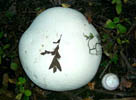(pl. mycorrhizae)
Terms discussed: arbuscule (pl. arbuscules), ectomycorrhizal, endomycorrhizal, Hartig net, mantle (pl. mantles), mycorrhizal, VA, VAM, vesicle (pl. vesicles), vesicular-arbuscular
See Also:
Fungal Lifestyle
A mycorrhiza is a symbiotic relationship between a plant and a fungus (actually, usually many fungi) - - the fungus attaches itself to the plants roots and functions as an extended root system for the plant, seeking out water and minerals that the plant can't get to. This is especially important in the case of minerals, like phosphorus, that don't diffuse very well in water: it's necessary to be right at the source instead of waiting for the mineral to diffuse over to you in the groundwater. Since a fungus' mycelium is only one cell thick, it can cover the territory in much more detail than the plant's roots can, and work its way into wherever it needs to go. In return, the fungus gets sugars from the plant. A fungus which has this type of relationship with a plant is called mycorrhizal.
Back to top
Fungi form two kinds of mycorrhizae: those that penetrate the cell wall of the plant's root and those that do not. The ones that do not are called ectomycorrhizal; those that do are called endomycorrhizal or, more commonly today, VAM fungi.
Back to top
Most ectomycorrhizal fungi are macrofungi, basidiomycetes such as boletes or gilled fungi. The mycelium of ectomycorrhizal fungi forms a sheath, or mantle, around the roots of the symbiont plant. From the mantle, a hyphal network called the Hartig net extends into the root, between the cells, usually just a few cells deep. The early research on ectomycorrhizal fungi and the anatomy of the interface between symbionts was done by Robert Hartig, so the Hartig net is named after him.
Back to top
Most endomycorrhizal fungi are in the order Glomales, and their fruiting bodies are hypogeous, when they are large enough to be seen at all. Many of these fungi have no fruiting body at all, reproducing entirely by spores produced one at a time on the hyphae. The mycelium of endomycorrhizal fungi actually grows into the cells of the symbiont plant, producing highly branched structures (known as an arbuscule, or "little tree") inside the cell wall but outside the plasma membrane. The plasma membrane of the plant cell becomes wrapped around the arbuscule, providing lots of surface area for the exchange of nutrients between plant and fungus. The arbuscules only last a few days before they are dissolved and digested by the host plant, so they are constantly growing and dissolving in the roots of a plant with this type of mycorrhiza.
Back to top
Endomycorrhizal fungi also form swollen end cells called vesicles, either between root cells or within the cell wall. These vesicles are thought to be storage locations for fungal food reserves. The term "vesicle" can also be used in a wider sense, for any cell or organ that is inflated by the stuff that it is used to store; but at the moment, it is mostly used in connection with endomycorrhizal fungi.
Back to top
Because of the vesicles and arbuscules that they form, endomycorrhizae are sometimes called vesicular-arbuscular mycorrhizae, or VA mycorrhizae. Carrying the abbreviation process one step further, the fungi that form VA mycorrhizae are sometimes known as VAM fungi, and this term is more common nowadays than endomycorrhiza.
Back to top
Some of the fungi in the Ceratobasidiales and Tulasnellales have a special type of mycorrhizal relationship with orchids, but I don't have the sources to cover that right now, nor the time to hunt them down.
Back to top











